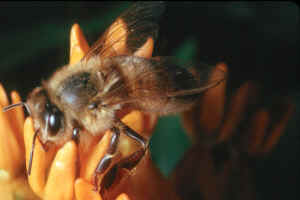 .
.
Wild Flowers and Their Associates Photos 001-020
A click on the number of a photo produces an enlargement to 800 by 600 pixels. A click on the photo produces a smaller enlargement.
Photo 001. Common Honey Bee on Butterfly Weed
Photo 002. Common Honey Bee on Butterfly Weed
Photo 003. Common Honey Bee on Butterfly Weed
Photo 004. Common Honey Bee on Butterfly Weed
Photo 005. Common Honey Bee on a member of the mint family.
Photo 006. Potato Beetle on a leaf.
Photo 007. Earwig from the floor of a Florida motel (noticed when it pinched the heel of a bare foot).
Photo 008. A large handsome South Florida grasshopper that is easily identified as Schistocerca americana (From Riley) by the drawing and description on page 256 of Professor John Henry Comstock's "An Introduction to Entomology", Comstock Publishing Associates, A Division of Cornell University Press, Ithaca, New York, Ninth Edition, Revised, October 1967. Scientific names can change as experts acquire altered viewpoints, modify classifications, and follow prescribed rules of priority. For us, the most recent correct name is less useful than having a convenient source in which one can find an accurate description of the individual. The insect in Photo 007 is clearly recognized as an Earwig; but to decide which of the approximately 400 individuals it might be is truly the work for an interested specialist. Common names are fine when there is no ambiguity at all or when ignorance precludes use of a scientific name.
Photo 009. A moth of the species Automeris Io (photographed on the cover of an examination booklet).
Photo 010. The front portion of a Luna moth.
Photo 011. Soldier Beetle on Butterfly Weed
Photo 012. Bumble Bee on New England Astor
Photo 013. Bumble Bee on a Mint
Photo 014. Bumble Bee on Common Milkweed
Photo 015. Everglade Bee on Bidens leucantha. In our area, Bidens frondosa and other species of Bidens produce the seeds, the achenes, called devil's pitchforks, that easily attach themselves with two prongs to clothing when one walks during autumn into a field where the plant occurs.
Photo 016. A stinkbug ---a true bug (notice how the wings fold)
Photo 017. Micrathena gracilis on a blue examination booklet. This is the female of an orb weaving spider whose webs are very common in local forests in the Cincinnati area during the summer months. At the Lloyd Forest near Crittendon, Kentucky in July of 1969, there were numerous webs of orb-weaving spiders across the hiking paths. Most were produced by spiders of this species. The unusual spines on its abdomen made it easy to identify from the picture on page 526 of Professor John Henry Comstock's "The Spider Book", Comstock Publishing Associates, Cornell University Press, Ithaca, New York, Second Printing, 1967 (First Printing, 1912). The success of this first identification using his book encouraged me to use its descriptions as the basis for the naming of the spiders in my other photographs. Unlike various insects where numerous similar species can occur, there appear to be relative few species of spiders that give similar difficulty. However, the names of more than a few spiders have led to controversy among experts. While Professor Comstock's book lacks some of the latest professionally approved scientific names, its descriptions are accurate and very useful. Thus, except for Photo 067, we shall base our study of spiders on the names and descriptions in Professor Comstock's "The Spider Book".
Photo 018. The web of a particular Micrathena gracilis spider at the Lloyd Forest. The web is constructed in a vertical plane and the spider hangs head downward in the center of the web when waiting for a prey. The distance from left to right across the spirals is about 3 feet.
Photo 019. Gasteracantha cancriformis. (Commstock, p. 526) This is a female orb weaving spider from South Florida that is shown here out of its natural environment. Like Micrathena gracilis, it also has spines on its abdomen.
Photo 020. Rear view of Gasteracantha cancriformis.
Return to starting page for Wild Flowers and Their Associates